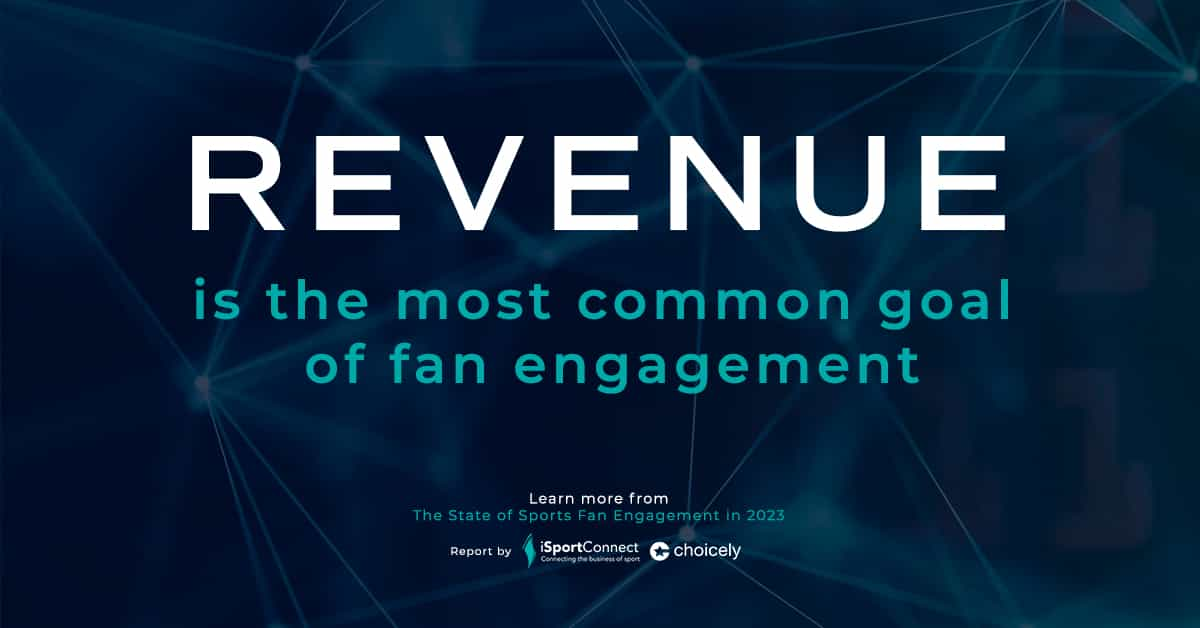- App Platform
- Pricing
- References
-
Apps as a Service
-
Mobile App as a Service
Get a tailored app done for you
-
Contest Voting App
Boost your voting contest with an app
-
Pageant Voting System
Create a flashy app for your pageant
-
Fan engagement app
Grow your fan engagement with an app
-
News app
Grow engagement with your readers
-
Event app
Engage your attendees
-
 TV Show app
TV Show appGrow interactions with your viewers
-
- Resources
- Work With Us

But why is it so important? Let’s have a look at the top three reasons.
1. Fan engagement drives revenue and loyalty
Fans are the lifeblood of a sports organization, whether you work for a club, league or a sports federation.
It pays off to build a lasting bond with the fans. Consumers who have an emotional connection with a brand have a 306% higher lifetime value than those who are only satisfied.
This is because engaged fans are more committed long-term supporters of the brand, who are also more likely to purchase merchandise and attend more events, thus affecting their customer lifetime value to the organization.

Fans that describe themselves as “fanatics” spend 6 times more annually than casual fans, according to Deloitte’s research. Additionally, season-ticket holders spend 5 times than non-season ticket holders.
Also in the State of Sports Fan Engagement 2023 study, revenue was named as the most common goal of fan engagement.
Fan engagement makes a lot of sense from a business point of view. It builds better fan monetization opportunities and long-term fandom.
Mobile apps are a great way to monetize your fans. With Choicely app builder, you can create your own Sports Fan app without any coding skills.
2. Passionate fans bring more fans
People don’t become fans of a sports club the same way consumers become customers of a brand. Fandom is strongly linked to social circles, not logical arguments or a need to get something done.
According to Adam Earnhardt, Chairman of the Communications Department at Youngstown State University and co-author of “Sports Fans, Identity and Socialization: Exploring the Fandemonium”, the most common reason for people to become fans is the connection to their first community, meaning close friends and especially family.
Engaged fans spread the word and share experiences – like attending games together – with their social connections. These types of events can lead to someone becoming a fan of the same club, and sharing the same passion as their peers.
92% of consumers trust recommendations made by friends and family over other types of marketing. Word-of-mouth is the most effective form of marketing, and it applies especially in sports.
3. Understanding your fanbase and collecting fan feedback
Engaging with fans is a great opportunity to learn about their preferences and opinions, and use the insights to improve the sports business.
A sports organization can also give more power to their fans by letting them vote and decide on things regarding the sports club.
You survey fans and learn how happy they are with how the organization is run, and what could be improved in their opinion.
Net Promoter Score (NPS) is one of the most popular customer satisfaction metrics and survey types.
It also applies very well in the context of sports organizations.
In NPS, the respondent is asked a numerical value of how likely they are to recommend the product or service to their peers. On top of the numerical answer, the respondent is asked to explain why they gave the number they did.
The NPS value doesn't lie, it really predicts referrals.
It's also proven to correlate with the upsale revenue and overall revenue growth of a business. According to Bain & Company an industry's Net Promoter Score leader outgrew its competitors by over 2X.
The key to leveraging NPS is to react to the fan feedback. This way you can strengthen the bond between your sports brand and the fans, and show that their input matters.
This is one example of how engaging with your fanbase can help measure the level of fan engagement, and improve it for better business results.
How to increase fan engagement
Increasing fan engagement starts from defining a clear strategy. It’s built on three key steps:
- Define your fan engagement goals
- Understand your fanbase
- Choose your fan engagement tactics
When the first two are defined, the tactics on how to drive fan engagement are the logical next step.
Let’s dive further into these steps!
1. Define your fan engagement goals
Like any business initiative, fan engagement starts from defining your goals, which are unique to your organization. Also, the line between fan engagement and monetization can be hard to distinguish, and often these go hand in hand.
According to the State of Sports Fan Engagement 2023 study, the most common fan engagement goals are growing revenue, website traffic, social followers and app users:
Let’s look into each goal with more detail.
GROW REVENUE OR INCOME
According to the State of Sports Fan Engagement 2023 study, growing revenue or income is the most common overarching fan engagement goal. Subgoals can include things like:
- Growing ticket sales
- Growing sponsorships
- Grow merchandise sales
This goal is all about monetization.
However, all of the above are linked to the size of your audience: at your events, on your digital platforms, your owned media, and the overall visibility and awareness of your sports brand.
This takes us to the next point.
GROW DIGITAL TRAFFIC AND ENGAGEMENT
Metrics tied to traffic and engagement on digital platforms are the second most common fan engagement goals that sports professionals name. These goals take up the 2nd, 3rd and 4th places after growing revenue in our study:
- Grow website traffic (23% of respondents naming it)
- Grow social followers (18%)
- Grow app users (17%)
Besides sheer traffic, followers and users, it’s also important for sports brands to measure the level of engagement with their fans. Look into things like:
- How long do fans spend time on our website or mobile app?
- How much do fans engage with our social media posts eg. by liking, commenting and sharing?
- How often do they take part in our fan activations, like contests on our website?
GROW 1st PARTY FAN DATA
Growing first party data was the 5th most common fan engagement goal named by sports business professionals with 8% naming it – out of 6 options.
As 3rd party cookie tracking is limited, the importance of 1st party data has been “all the rage” among the marketing industry. Seems that this trend isn’t as pronounced among the sports world.
Collecting first party data, growing a database or fan registry in practice means gathering data through your owned digital platforms like website, mobile app and email; and collecting contact information through these platforms in exchange for perks, draws and other prizes.
With fan data, sports organizations can further market to them directly, segment their audience and send them personalized content and offers.
GROW ATTENDANCE
Growing attendance is the fan engagement goal sports business professionals mentioned the least often, which is very surprising.
Perhaps attendance goals aren’t even seen as part of fan engagement? Or it's already included under 'growing revenue or income'.
Overall, growing attendance is a common goal across the sports industry. Engaging the audience at sporting events is also another aspect of fan engagement.
OTHER POSSIBLE FAN ENGAGEMENT GOALS
Here are more suggestions for goals that are tied to sports fan engagement:
Gaining new fans
- Eg. registered fans attending match for the 1st time
Fan activation and retention
- Eg. amount of active fans per month (by purchases, other registered activities), tracked in the CRM / fan registry
Image / PR of the sport, or sports club
- Results of brand awareness and perception study
- Findings of media monitoring
Registered members
Active hobbyists- Studies on the hobbyists
- Combined data from sports venues
After defining the unique goals of your organization, it’s natural to move on to see how they can become a reality.
But first…
2. Understand your fanbase
Like we discussed before, understanding your fanbase is crucial to your fan engagement success – and it all comes down to revenue and income.
To make successful choices when it comes to engagement channels, platforms, content formats, or service providers, the organization needs to know its fans first:
Market research
- Quantitative and qualitative studies of your fans
- Collecting feedback in a lean way directly from your fans (eg. through fan apps or website tools)
Engagement data from digital platforms
- Website, social media and app data
- Experimentation: eg. what kind of content has worked well in engaging fans across digital platforms, and what hasn't
Your fan registry data
Experience
- The experience of your staff, internal interviews
Public data and market research
By combining this data with your fan engagement should give you ideas on what kind of tactical choices you should make – looking at it from the fan perspective.
You don’t have to tick all of the above boxes, but the more you hit the better. It's especially advisable to approach fans directly with surveys and interviews, and be engaged in the fan community first hand.
3. Choose fan engagement tactics
Fans now have more ways to interact with their favorite teams and leagues than ever before.
Let's look into our study data on the most popular digital platforms and content formats in sports fan engagement:
Digital channels
According to our research the most important digital platforms are:
- Social media
- OTT streaming platforms
- Mobile apps
- Website
- Podcast
- Television
- Gaming console
As discussed, you need to know your fans to choose the right platforms as fans’ unique behavior determines how you should approach them. Still, the importance of some platforms is undeniable.
Comparing the survey data of sports business professionals, the most underappreciated channel is television. On one hand, television might not even be seen as an “engagement” channel which explains the small number in the survey.
96% of fans engage in second screen behavior with another device while watching sports on TV. For most, that device is mobile apps. This makes these two platforms a great combo for fan engagement.
Learn more about growing digital fan engagement with mobile apps.
Content formats
There are a plenty of ways to drive fan engagement. Listed below you can see what were the most common content formats named by sports industry professionals in the State of Sports Fan Engagement 2023 study:
- Video (live & non-live)
- Interactive (Polls, surveys, voting, quizzes)
- Statistics & Scores
- Text (direct messages)
- Audio (Podcasts)
- Images
- Betting
- Fantasy
- Live chat
Video plays a big part in all of sports, in the form of live feeds, highlights and interviews. Interactive content was seen as the second most important content format, even ahead of statistics and scores. As a sports organization, you’re likely to hit the nail on the head by placing emphasis on these formats.
Other content formats include:
- Gamification
- Augmented Reality (AR), Virtual Reality (VR) and Mixed Reality (MR) experiences
- AI Chatbots
- AI generated content
- Personalized experiences
- Branded clothing and products (“swag”)
- Promotions, deals, giveaways and rewards
Some of these new content formats are trending heavily. In the State of Sports Fan Engagement 2023 study 33% of respondents believed AR, VR and MR experiences will revolutionize the sports business in the next 3–5 years, being the most common answer.
Sports business professionals also expect AI to play a big role, especially in data analysis and in making data-driven decisions with 29% choosing that option. Generative AI was 3rd most popular answer with 14%.
Conclusion
Succeeding in fan engagement is crucial for sports organizations: the benefits that engaged and loyal fans generate are clear. Fan engagement is tied to revenue, growth and financial performance of the organization.
Possibilities are endless in growing your digital fan engagement. Start creating your fan engagement strategy by defining clear goals and building a good understanding of your fans. Follow by selecting the most fitting tactics, channels, content formats and technologies.
Build your own Sports Fan App with Choicely
With Choicely, you can create a world-class app without any coding skills. Try the Choicely App Builder for free. You don't need to pay until you're ready to publish your app!









